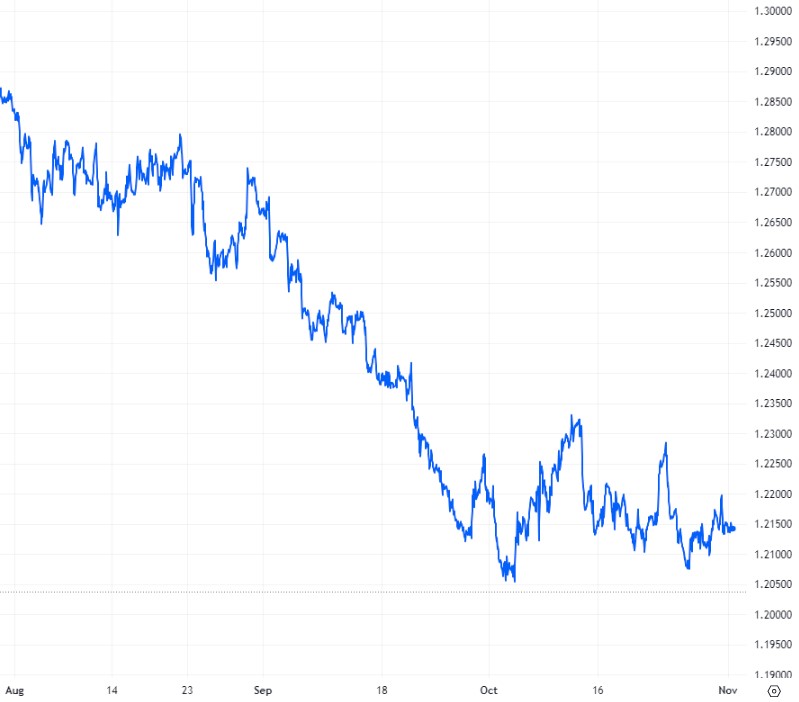GBP-USD Exchange Rate Plummets to Six-and-a-half-month Low in October
The pound suffered a hangover from September – its worst month in a year against the dollar – at the start of the month, slumping to its lowest level since mid-March on 3 October. Its fall to within a whisker of the 1.20 benchmark marked a six-and-a-half-month low.
The move lower came as the dollar strengthened amid concerns that interest rates will stay high for longer than expected, thanks to the strength of the US economy. In contrast, the Bank of England (BoE) may have ended its hiking cycle, after leaving UK interest rates on hold in September.
The pound soon received a tonic in the form of a better-than-expected UK service sector PMI print, helping it to rebound into the 1.21 mid-range against the dollar.
The latest US non-farm payrolls report on 6 October smashed forecasts, with the US economy adding 336,000 jobs in September, almost double the expected 170,000. August’s figure was also revised up from 187,000 to 227,000.
The red-hot report caused the dollar to briefly surge against the pound, which managed to recoup all its losses with interest. Despite there not being a clear catalyst for the UK currency’s rally, it managed to jump above 1.22.
The pound’s gains were soon arrested by concerns over conflict in the Middle East, which caused investors to take flight toward the safe-haven dollar on 9 October.
Comments from Federal Reserve officials created headwinds for the dollar the following day. Much of their commentary indicated that the US central bank’s recent rate hiking cycle may be coming to an end ahead of its next rate decision in November.
The GBP-USD pair rose to a fresh three-week high above the 1.23 benchmark on 11 October, with investors unmoved by a stronger-than-forecast US producer price index.
The pound ran out of steam the following day in the wake of the US consumer price index (CPI) for September, causing it to tumble into the 1.21 range.
The CPI showed that headline inflation remained firm at 3.7% in September, rather than easing to 3.6% as forecast. Investors subsequently raised bets on another Fed rate hike before the end of the year.
Following a brief resurgence, UK jobs data released on 17 October weighed heavily on the pound, after a marginal decrease in average earnings further denting BoE rate hike bets.
Slightly higher-than-expected UK inflation data had little impact on the GBP-USD pair the following day, with investors and analysts expecting the BoE to leave interest rates on hold again in November.
The data showed that UK inflation remains the highest of the G7 countries, perpetuating concerns about the state of the UK economy.
The pound edged below the 1.21 level on 19 October, as escalating geopolitical tensions in the Middle East prompted a risk-off market mood that boosted the safe-haven dollar.
Lacklustre UK retail sales data dealt the pound a further blow soon after. Despite UK wage growth remaining robust, household spending is waning as high inflation and cost of living pressures continue to erode consumer confidence.
Having leapt into the 1.22 mid-range the previous day the GBP-USD pair spiralled on 24 October after the latest US private sector indexes gave the dollar a shot in the arm. Both services and manufacturing PMIs exceeded forecasts to climb out of contractionary territory.
The pound extended its losses as geopolitical tensions escalated in the Middle East, causing investors to pile into the safe haven dollar – dragging the GBP-USD pair to a three-week low in the 1.20 range.
The pair soon steadied itself after strong GDP data from the US economy buoyed markets, denting the dollar in the process.
US Inflation accelerated in September, but consumer spending was even stronger than expected. The core personal consumption expenditures price index, which the Fed uses as a key measure of inflation, increased 0.3% for the month, in line with forecasts – weakening the dollar further.
GBPUSD: 3-Month Chart

Looking ahead
The BoE’s expected to announce a second rate pause in a row on 2 November after almost two years of consecutive hikes.
Influential data from the UK economy in November: BoE interest rate decision (2 November), GDP (10 November), ILO Unemployment Rate (14 November), Consumer Price Index (15 November), Retail Sales (17 November), S&P Global/CIPS Composite PMI (21 November).
The Fed is expected to announce it will leave exchange rates untouched at the end of its two-day meeting on 1 November, even though its preferred inflation gauge remains well above the 2% target.
Influential data from the US economy in November: ADP Employment Change (1 November), ISM Manufacturing PMI (1 November), Fed interest rate decision (1 November), Average Hourly Earnings (3 November), Nonfarm Payrolls (3 December), ISM Services PMI (3 November), Michigan Consumer Sentiment Index (10 November), Consumer Price Index (14 November), Producer Price Index (15 November), Retail Sales (16 November), FOMC Minutes (21 November), S&P Global Manufacturing and services PMIs (24 November), GDP (29 November).






